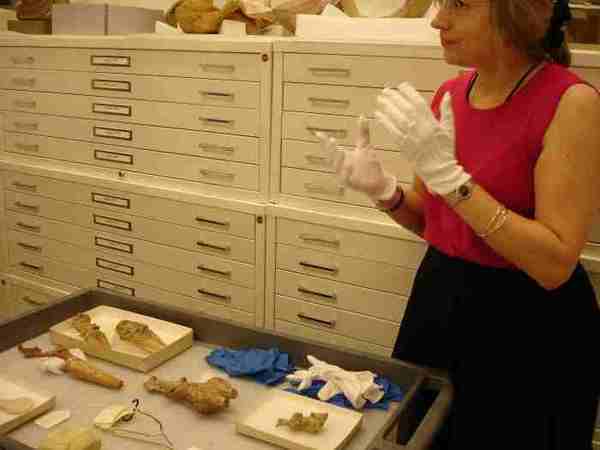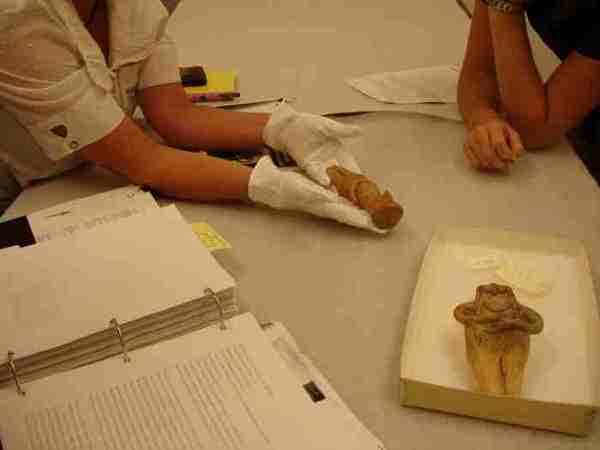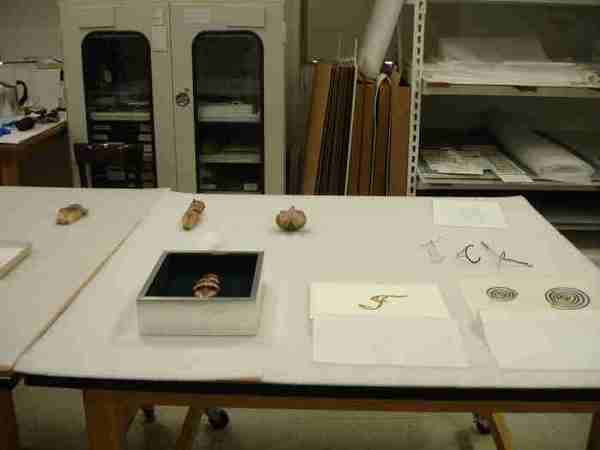The Fertile Goddess: Endings and Beginnings, Part II: Planning
Last summer we met in storage for a “bonding” session with the figures we selected from the collection for the show, where Maura, Ellen Belcher (our consultant), and I talked at length about each individual object. Much of what came out of these discussions was incorporated somehow into the labels for the exhibition. Photograph by Sarah Giovanniello.
Once we had established our criteria, nude female figurines with exaggerated or schematized forms, we needed to put together a list of potential objects for the show. This meant including figurines from the entire ancient world, not just Egypt and the ancient Middle East, so first I searched the object records in the Museum’s database and older card files to find appropriate candidates. I also visited other museums or scoured their websites to identify suitable figurine types and put together a bibliography of scholarly sources on these types in order to research them. Finally, I went into the Museum’s storage to look at the actual objects. I must say that, when it comes to ancient pieces, it is always a shock to see the real thing after looking at pictures. In this case, it brought home to me how powerful these figurines are in appearance despite their very small-scale; all of them can be held in one hand.
Most objects were small enough to fit in the palm of our hands! Photograph by Sarah Giovanniello.
After we chose nine objects to include, we had to schedule their examination and any necessary treatment by our conservators. This would determine if they could be displayed and whether there were any special restrictions on how we could display them based on their condition, always a major concern with any ancient object, some of which can be extremely fragile. We also needed to arrange for new color photography of each object, not least because Museum image records are now digital.
Meanwhile, Maura was arranging for loans of Chicago works related to The Fertile Goddess place setting, as is customary for Herstory exhibitions. We were really excited to get a large-scale version of one of Chicago’s figurines to compare with the ancient figurines, especially because it provided a visual reference to the older Paleolithic figurines, like The Venus of Willendorf, that inspired it. Maura and I both talked to Judy Chicago about the sources that inspired her figurines the books she had been looking at when she made them. For me, it was truly unprecedented to be able to consult an artist, as I am usually dealing with works that were made thousands of years ago!
During the exhibition mock-up for the show, we were able to situate the Chicago goddess sculpture and two Chicago Dinner Party sketches alongside the other objects for the first time. Photograph by Sarah Giovanniello.
Chicago’s figurine highlighted the issue of figurine types that were not represented in the Museum’s collection and what we wanted to do about including some reference to them. For example, there are no Paleolithic figurines in American collections, at least that we could find, although the American Museum of Natural History has a case with replicas of famous examples in the Hall of Human Origins. Maura came up with the fantastic idea of a world map on the gallery wall that would demonstrate the incredible range of such figurines over time and throughout the world. Implementing this also involved a lot of research and some surprises. I knew about figurines from the Paleolithic period, Old Europe, and other places in the ancient world, like the Indus valley, that I wanted to include but I had no idea that such figurines existed in China, Japan, and in Ecuador before our cutoff date at the end of the first millennium B.C.E. It was very gratifying to go to storage to see gorgeous examples of the third millennium B.C.E. from Ecuador that are in the Museum’s collection and to include them on the map.

Madeleine Cody is a Research Associate for Egyptian, Classical, and Ancient Middle Eastern Art. She has a B.A. in Classical and Near Eastern Archaeology from Bryn Mawr College, an MA in Egyptology from Brown University, and is currently completing her Ph.D. in Egyptian and Ancient Near Eastern Art and Archaeology at the Institute of Fine Arts, New York University. She has worked on excavations in Italy, Yemen and Egypt. Since coming to the Museum in 1997, she has been involved with numerous projects and assisted the late James F. Romano, Project Director, with the second phase of the reinstallation of the Egyptian Galleries, which opened in 2003. With Jim and Richard A. Fazzini, she is a co-author of Art for Eternity: Masterworks from Ancient Egypt (Brooklyn, 1999) and has written about other Egyptian objects from the Museum’s collection. Currently, she is working with the ancient Middle Eastern Art collection, her other area of expertise. She is co-curator of the Herstory Gallery exhibition, The Fertile Goddess, (December 19, 2008 – May 31, 2009).



